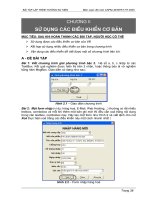Chuong 2 bootp dhcp
Bạn đang xem bản rút gọn của tài liệu. Xem và tải ngay bản đầy đủ của tài liệu tại đây (401.35 KB, 14 trang )
Chapter 16
Host Configuration:
BOOTP and DHCP
Objectives
Upon completion you will be able to:
• Know the types of information required by a system on boot-up
• Know how BOOTP operates
• Know how DHCP operates
• Understand the differences between BOOTP and DHCP
• Understand the DHCP transition state diagram
TCP/IP Protocol Suite
1
16.1 BOOTP
The Bootstrap Protocol (BOOTP) is a client/server protocol that
configures a diskless computer or a computer that is booted for the first
time. BOOTP provides the IP address, net mask, the address of a default
router, and the address of a name server.
The topics discussed in this section include:
Operation
Packet Format
TCP/IP Protocol Suite
2
Figure 16.1
TCP/IP Protocol Suite
Client and server on the same network
3
Figure 16.2
TCP/IP Protocol Suite
Client and server on two different networks
4
Figure 16.3
TCP/IP Protocol Suite
Use of UDP ports
5
Figure 16.4
TCP/IP Protocol Suite
BOOTP packet format
6
Figure 16.5
TCP/IP Protocol Suite
Option format
7
Table 16.1 Options for BOOTP
TCP/IP Protocol Suite
8
16.2 DHCP
The Dynamic Host Configuration Protocol (DHCP) provides static and
dynamic address allocation that can be manual or automatic.
The topics discussed in this section include:
Static Address Allocation
Dynamic Address Allocation
Manual and Automatic Configuration
Packet Format
Transition States
Exchanging Messages
TCP/IP Protocol Suite
9
Note:
DHCP provides static and dynamic
address allocation that can be manual
or automatic.
TCP/IP Protocol Suite
10
Figure 16.6
TCP/IP Protocol Suite
DHCP packet
11
Table 16.2 Options for DHCP
TCP/IP Protocol Suite
12
Figure 16.7
TCP/IP Protocol Suite
DHCP transition diagram
13
Figure 16.8
TCP/IP Protocol Suite
Exchanging messages
14









